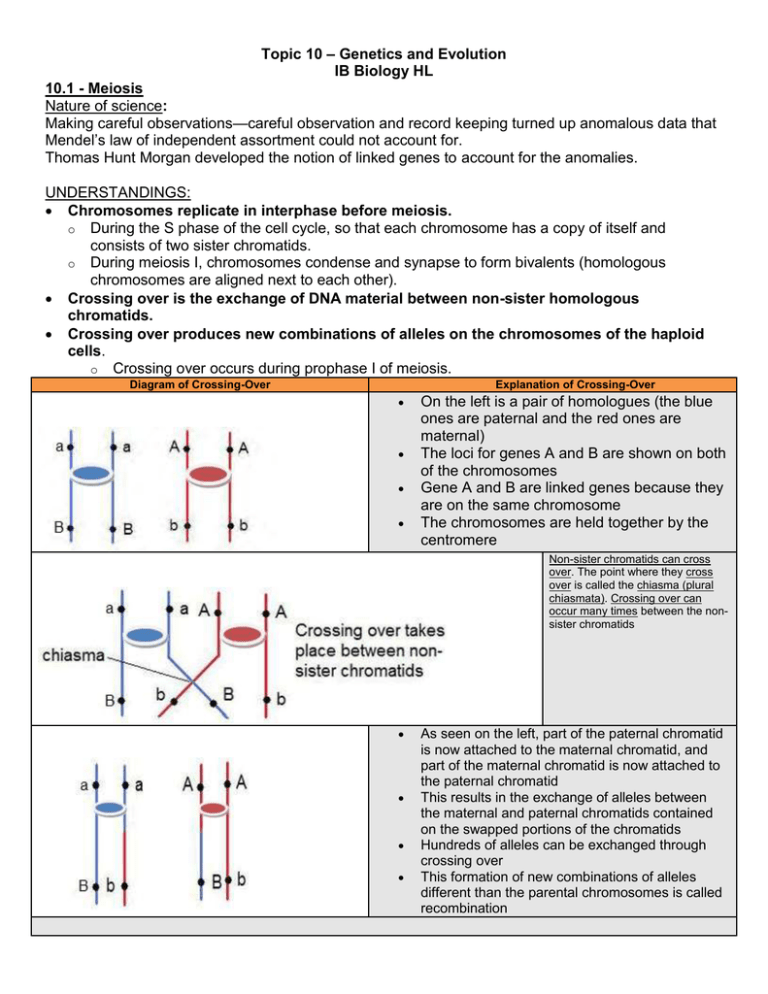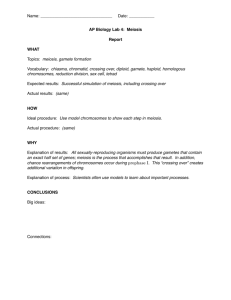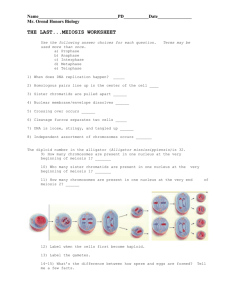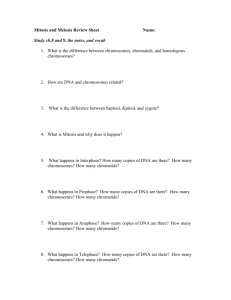File
advertisement

Topic 10 – Genetics and Evolution IB Biology HL 10.1 - Meiosis Nature of science: Making careful observations—careful observation and record keeping turned up anomalous data that Mendel’s law of independent assortment could not account for. Thomas Hunt Morgan developed the notion of linked genes to account for the anomalies. UNDERSTANDINGS: Chromosomes replicate in interphase before meiosis. o During the S phase of the cell cycle, so that each chromosome has a copy of itself and consists of two sister chromatids. o During meiosis I, chromosomes condense and synapse to form bivalents (homologous chromosomes are aligned next to each other). Crossing over is the exchange of DNA material between non-sister homologous chromatids. Crossing over produces new combinations of alleles on the chromosomes of the haploid cells. o Crossing over occurs during prophase I of meiosis. Diagram of Crossing-Over Explanation of Crossing-Over On the left is a pair of homologues (the blue ones are paternal and the red ones are maternal) The loci for genes A and B are shown on both of the chromosomes Gene A and B are linked genes because they are on the same chromosome The chromosomes are held together by the centromere Non-sister chromatids can cross over. The point where they cross over is called the chiasma (plural chiasmata). Crossing over can occur many times between the nonsister chromatids As seen on the left, part of the paternal chromatid is now attached to the maternal chromatid, and part of the maternal chromatid is now attached to the paternal chromatid This results in the exchange of alleles between the maternal and paternal chromatids contained on the swapped portions of the chromatids Hundreds of alleles can be exchanged through crossing over This formation of new combinations of alleles different than the parental chromosomes is called recombination **Crossing over only takes place some of the time between linked genes, therefore the parental combination in the gametes Ab and Ab will show up more often in the offspring, while ab and AB (recombinants) will show up with less frequency **Start: AaBb and AAbb Result after crossing over: Aabb and AABb Chiasmata formation between non-sister chromatids can result in an exchange of alleles (see in picture above as well). o Chiasmata are points where two homologous non-sister chromatids exchange genetic material during crossing over in meiosis. o Chromosomes intertwine and break at the exact same positions in non-sister chromatids. o The two chromosomes are now attached at the same corresponding position on the non-sister chromatid. o Many chiasmata can form between the chromatids. o Once attached the non-attached portions of the chromatids actually repel each other. o Chiasmata refer to the actual break of the phosphodiester bond during crossing over. o The chiasmata are separated during anaphase 1 which can result in an exchange of alleles between the non-sister chromatids from the maternal and paternal chromosomes. SKILL: Drawing diagrams to show chiasmata formed by crossing over. Homologous chromosomes separate in meiosis I. o During meiosis I, unlike mitosis homologous chromosomes separate to opposite poles; however, their sister chromatids remain attached to each other o Homologous chromosomes can exchange material in a process called crossing over o Meiosis I is considered reduction division because the chromosome number is reduced by half (2n -> n in humans) Sister chromatids separate in meiosis II. o During meiosis II sister chromatids separate (some are non-identical sister chromatids due to crossing over o This type of separation is very similar to mitosis as the chromatids are separated from each other Independent assortment of genes is due to the random orientation of pairs of homologous chromosomes in meiosis I. o When Mendel first did his experiments on pea plants, he looked at the traits that were passed on from generation to generation. He did not know how the traits were inherited in terms of meiosis. o We now know that independent assortment is an essential component in explaining how chromosomes align themselves during meiosis. o It also explains how unlinked genes are passed on from generation to generation. o As explained above, when homologues line up along the equatorial plate in metaphase I, the orientation of each pair of is random; meaning the maternal or paternal homologue can orient towards either pole. o Also the orientation of how one set of homologues line up has no effect on how any of the other homologues line up. o o o For example, if chromosome pair one is heterozygous for a certain trait, there is a 50% chance that the gamete will receive the dominant trait and a 50% chance that the gamete will receive the recessive trait. Also if chromosome pair five is heterozygous for a particular trait, again there is a 50% chance that the gamete will receive the dominant allele and a 50% chance that it will receive the recessive allele. Both of these homologues line up independently during meiosis and have no effect on which gamete the other alleles will end up in.








